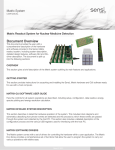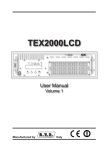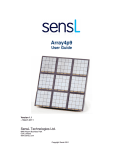Download 4-Side Scalable Silicon Photomultiplier Array Contents
Transcript
ArraySM-4 Scalable Silicon Photomultiplier Array USER MANUAL 4-Side Scalable Silicon Photomultiplier Array SensL introduces its 16-pixel Silicon Photomultipler ArraySM. It is based upon a 4x4 arrangement of 3mm SPM pixels which are mounted in a low profile ceramic package. The ArraySM-4 permits close packing on all four sides allowing for a detection area that can be as large or small as required by the specific application. It is the first commercially available detector of its kind and will be of particular interest to developers of imaging systems for PET, gamma cameras, nuclear hazard and threat detection and fluorescence measurements. This User Manual summarizes the technical information relating to the ArraySM-4 detector and its supporting electronics, and describes their performance and use. Contents ArraySM-4 Product Overview......................................................................................................................................................... 2 Getting Started................................................................................................................................................................................ 2 Unpacking the System and Preparation for Use......................................................................................................................... 2 Handling and Use Considerations............................................................................................................................................... 3 Technical Issues and support..................................................................................................................................................... 3 ArraySM-4 Specifications............................................................................................................................................................... 4 Pixel Map & Pin Locations.......................................................................................................................................................... 5 Detector Connections................................................................................................................................................................ 6 ArraySM-4 Detector Bias............................................................................................................................................................ 6 ArraySM-4 Electronics ................................................................................................................................................................... 7 Array4-EVB-PixOut: Evaluation board for ArraySM-4 pixel/summed outputs.............................................................................. 7 Array4-EVB-Preamp: 16-Channel Preamplification board........................................................................................................... 7 Setting Up the ArraySM-4 & Electronics Boards........................................................................................................................... 15 Schematics...................................................................................................................................................................................... 16 ArraySM-4 Detector................................................................................................................................................................... 16 Array4-EVB-Preamp................................................................................................................................................................... 17 Array4-EVB-Pixout..................................................................................................................................................................... 18 Appendix A...................................................................................................................................................................................... 19 Setting Signal Output Polarity on the Array4-EVB-PixOut........................................................................................................... 19 SensL © 2012 1 ArraySM-4 Scalable Silicon Photomultiplier Array USER MANUAL ArraySM-4 Product Overview SensL’s Position Sensitive / Multi Anode Silicon Photomultiplier Array (ArraySM-4) is a large area detector based on silicon photomultiplier technology. The 16-pixel ArraySM-4 is mounted onto a low profile ceramic package which allows 4-side tiling to allow ArraySM-4 to be scaled for larger area detection systems. A non magnetic sensitive package has been developed using Ni free processing and materials with low magnetic susceptibility. A 20pin grid array (PGA) footprint is employed for electrical I/O to a printed circuit board or to a standard test socket connector. The pixel array is over molded with epoxy to completely encapsulate the pixels, bond wires and substrate bond pads. The pixel bias and readout configuration has been designed for both differential and single channel readout electronics. The performance and specification characteristics of each pixel are the same as SensL’s MicroSM-30035 products (the datasheet can be found on the website). The device is sensitive to visible light in the range of 400nm to 1000nm and suited to applications requiring direct light detection or for radiation detection via scintillators. The ArraySM-4 package is designed in such a way that multiple arrays can be tiled together. This allows NxM arrays to be seamlessly assembled into a larger area detection plane. Whether the application requires a 1D array for spectrometry or a 2D array for large area detection with position sensitivity, the ArraySM-4 is a novel detector solution and the ideal replacement for MCPs, Multi-Anode PMTs, APDs, and existing discrete SPM products. • 16 (4 x 4) elements of 3mm pixels • High pixel to pixel output uniformity (uniformity ratio <1:1.5) • Low external package deadspace allowing for NxM configurations • High gain (106) pixel • Low bias voltage operation (~30V) • Compact footprint interface electronics with form factor matched to ArraySM-4 width for tilling • Multi-channel differential pre-amplification and convenient power supply • Pixellated or summed output via interface electronics Getting Started UNPACKING THE SYSTEM AND PREPARATION FOR USE Contents of the Package: • ArraySM-4 Detector Module - 4X4 element array of 3mm SPMs (type MicroSM-30035) mounted in 20-pin ceramic package • Array4-EVB-PreAmp (optional): 16-channel preamplifier board for ArraySM-4 • Array4-EVB-PixOut (optional): Evaluation board for ArraySM-4 for pixellated or summed signal output, with power supply • Array-Opt-PGA20P (optional): 20-pin straight terminal SMT socket Note: Unpack the contents carefully and identify each of the components. Normal ESD-aware handling protocols should be observed. SensL © 2012 2 ArraySM-4 Scalable Silicon Photomultiplier Array USER MANUAL Figure 1: The complete Array4 product range, showing detector, Preamp board and the PixOut board. HANDLING AND USE CONSIDERATIONS • The module is not intended for outdoor use. • If a preamp board is provided with a given sensor it is not recommended that the user separate them. The preamp board will have had its bias setting precisely optimized based on that sensor’s breakdown. Therefore if the preamp board is used with other sensors, optimum performance cannot be guaranteed. • The sensor and electronics should be kept away from liquids which if spilled on them could cause failure. • Apply only the correct supply voltages and observe correct polarity. Operational voltage is POSITIVE relative to the ground rail. For example, if an operating voltage of 29V is required then the voltage applied to Vbias should be +29V. Do not expose the sensor to extended periods of ambient light with biased applied. To do so may cause failure of the device through excessive current draw. • For optical coupling, bonding directly to the clear epoxy surface is not recommended. Optical surfaces should be held in place mechanically and optical coupling optimised using refractive index matching gel. • These devices are ESD sensitive. The following precautions are recommended: • Ensure that personal grounding, environmental controls and work surfaces are compliant with recommendations in JESD625. • Ensure that all personnel handling these devices are trained according to the recommendations in JESD625. • Devices must be placed in an ESD approved carrier during transport through an uncontrolled area. TECHNICAL ISSUES AND SUPPORT In the event of defects in material or workmanship, or a failure to meet specifications, promptly notify your local sales agent. They can advise whether it will be necessary to contact SensL directly. To contact SensL directly, email [email protected], or call the phone numbers at the end of this document. Supporting documentation, including datasheets and technical notes can be found on the website, www.sensl.com. SensL © 2012 3 ArraySM-4 Scalable Silicon Photomultiplier Array USER MANUAL ArraySM-4 Specifications Table 1: ArraySM-4 (Detector Specifications) Parameter Part Number Units ArraySM-4-30035 Test Conditions Pixel Chip Area 3.16 x 3.16 mm2 3.16 ± 0.01mm to account for scribe cut of die (kerf) Pixel Active Area 2.85 x 2.85 mm2 - Breakdown Voltage (VBr) 27.5 ± 0.5 V Operating Voltage Range (above VBr) 1-5 V Array Layout 4x4 Pixels 2.3x106 - 13.4 x 13.4 mm 4774 Per pixel 20 % 3.8 mA MicroSM-30035-X13 - Microcell Gain Total Pixel Effective Area Number of Microcells Photon Detection Efficiency Dark Current Detailed Specifications of Pixel Positive bias Number of Pixels: 16 - 2 at Vop, lmax = 500nm Per pixel See Datasheet - available on www.sensl.com Table 2: ArraySM-4 (Module Specifications) Parameter Part Number ArraySM-4-30035 Units Comments Pixel to Pixel Spacing 200 µm Deadspace. See Schematics for layout. Pixel Pitch 3.36 mm - Pixel Thickness 450 ± 25 µm - Ceramic Type Alumina Al2O3 - - Ceramic Color Black - - Ceramic Base 500 µm - 15.81 x 15.31 mm - Cu Pin Grid Array (PGA) - 1.5 mm Ceramic Package Size Electrical I/O’s Ceramic Package Height Pin Type 2 See Schematics Includes ceramic base thickness Cu - Frame Height 1000 µm Al2O3 frame which surrounds tiled array Pin Spacing 1.27 mm Standard pin spacing— sockets see www.e-tec.co.uk [Part No. PSC-520-E118-95-I] Epotek 301-2 - Epoxy Encapsulate Epoxy Thickness Epoxy: Refractive Index Epoxy: Spectral Transmission <500 µm 1.5318 - Measured at 589nm Thickness coated over the surface of the die >98 % Measured at 550-900nm SensL © 2012 4 ArraySM-4 Scalable Silicon Photomultiplier Array USER MANUAL PIXEL MAP & PIN LOCATIONS Figure 2: Top-down view of the ArraySM-4 pixel layout. Figure 3: Bottom (pin side) and side views of the ArraySM-4 detector package showing pin layout and naming. SensL © 2012 5 ArraySM-4 Scalable Silicon Photomultiplier Array USER MANUAL DETECTOR CONNECTIONS Table 3 details the ArraySM-4 package connections which should be used in conjunction with the pin locations shown in Figure 3 and pixel layout shown in Figure 2. The bias needs to be applied to 4 individual pins. Each pin supplies the bias to the daisy-chained cathode connections of the 4 pixels in a particular row of the array, as shown in Figure 2. The signal connections from the back-side anode contacts of the array are individually routed to the remaining 16 pins of the package. Table 3: Description of signals on the ArraySM-4 package ArraySM-4 Pin Connection Signal Name Description P1 HV1 Bias voltage connection to cathodes of CellA, CellB, CellC & CellD P2 CellA(p) Anode signal connection for CellA P3 CellE(p) Anode signal connection for CellE P4 HV2 Bias voltage connection to cathodes of CellE, CellF, CellG & CellH P5 CellF(p) Anode signal connection for CellF P6 CellI(p) Anode signal connection for CellI P7 HV3 Bias voltage connection to cathodes of CellI, CellJ, CellK & CellL P8 CellJ(p) Anode signal connection for CellJ P9 CellM(p) Anode signal connection for CellM P10 HV4 Bias voltage connection to cathodes of CellM, CellN, CellO & CellP P11 CellO(p) Anode signal connection for CellO P12 CellP(p) Anode signal connection for CellP P13 CellN(p) Anode signal connection for CellN P14 CellK(p) Anode signal connection for CellK P15 CellL(p) Anode signal connection for CellL P16 CellG(p) Anode signal connection for CellG P17 CellH(p) Anode signal connection for CellH P18 CellB(p) Anode signal connection for CellB P19 CellC(p) Anode signal connection for CellC P20 CellD(p) Anode signal connection for CellD ARRAYSM-4 DETECTOR BIAS The array is designed for positive bias operation. The typical breakdown voltage and operational range for the device is stated in Table 1. Please ensure that the operation voltage is POSITIVE relative to the ground rail. For example, if the operating voltage (Vop) is 29V then the voltage applied to Vbias should be +29V. Table 3 details the bias connections required. The pixel and pin layout are shown in Figure 2 & Figure 3 respectively. SensL © 2012 6 ArraySM-4 Scalable Silicon Photomultiplier Array USER MANUAL ArraySM-4 Electronics The ArraySM-4 detector is offered with the option of custom supporting electronics: a 16-channel preamplification board (Array4-EVBPreAmp) and an evaluation board for pixellated/summed pixel output via SMA connector (Array4-EVB-PixOut). ARRAY4-EVB-PIXOUT: EVALUATION BOARD FOR ARRAYSM-4 PIXEL/SUMMED OUTPUTS The key features and benefits of the Array4-EVB-PixOut evaluation board are as follows: • Allows fast evaluation of ArraySM-4 and Array4-EVB-PreAmp board. • 16 individual SMA sockets for monitoring the pixel signal on an oscilloscope, for example. The differential signals from the PreAmp board are combined into a single output on the PixOut board, as shown in Figure 4. • Additional summed pixel output on a SMA connector. • Board-to-board 80-way 0.5mm pitch connector for plugging into the PreAmp board (differential output signals, power supply, bias supply, stepped down bias monitor, SPI interface). • 6V DC power supply provided by a universal AC adapter. • On board regulation to provide +/-3.3V preamplifier supply. • On board switching regulator to provide +36V input to the step down regulator on the PreAmp board. • FFC connector should remote positioning of the evaluation board from the PreAmp board be required (e.g. for environments where there are strong magnetic fields). Figure 4: Schematic of the method used to combine the differential signals to a single output on the PixOut board. ARRAY4-EVB-PREAMP: 16-CHANNEL PREAMPLIFICATION BOARD The Array4-EVB-PreAmp board has several functions. It independently preamplifies signals from each of the 16 pixels of the ArraySM-4 giving a differential output for each channel. It also contains a regulator which is programmed to output the optimal bias voltage for the array. Customers may wish to connect the preamplifier to their own system or to use the Array4-EVB-PixOut evaluation board. The output signals from the preamplifier are available on a 50-way FFC 0.5mm pitch connector. The differential nature of the signals ensures low crosstalk allowing this compact connection system to be used. The user’s own electronics should then have a similar FFC connector and may contain circuitry such as analogue-to-digital converters and digital signal processing. The key features of the Array4-EVB-PreAmp electronics are as follows: • 16-channel, differential preamplifier design based on the AD8132. SensL © 2012 7 ArraySM-4 Scalable Silicon Photomultiplier Array USER MANUAL • Required power supply +/-3.3V default (range from +/-2.7V to +/-5V absolute maximum). • Differential preamplification output for each pixel with common mode voltage at ground for low crosstalk. • Compact preamplification differential output via 50-way FFC (flat flexible cable) or 80-way board-to-board connector. • Power input via the FFC, 4-way Sherlock connector or board-to-board connector. • Read back monitor of programmed bias voltage on FFC and board-to-board connector. • Positive Input bias supply: +34V to +40V (50mA maximum) supply which is stepped down and regulated on the PreAmp board to bias the pixels. • Power supply select jumpers: - Jumper to bypass preamplifier bias regulator and to apply direct bias to the ArraySM-4 from e.g. a bench supply. (See test sheet for recommended bias voltage). - Jumper allows the regulator to be supplied from the either the board-to-board connector/FPC connector or the Sherlock connector. • Board-to-board, 80-way 0.5mm pitch connector for plugging into the Array4-EVB-PixOut evaluation board, which allows access to each signal via SMA individually, or the sum of all 16 pixel signals to simulate a large-area detector. Figure 5: Top and bottom views of the preamplification board SensL © 2012 8 ArraySM-4 Scalable Silicon Photomultiplier Array USER MANUAL Differential Preamplification The 16-channel PreAmp board uses fast, charge-sensitive (integrating), differential output preamplifiers. The preamplifiers are implemented using Analog Device’s AD8132 chips. Differential signals allow the use of a compact FFC cable, reducing channel-to-channel crosstalk and sensitivity to ground potential variations across the system compared with a single-ended amplification system. Figure 6: Single channel preamplification schematic The preamplifier for each of the 16 channels is configured in transimpedance mode as shown in Figure 6. The gain is defined by R1, while C1 and R4 provide stability (ringing suppression) of the transient response. Resistors R2 and R3 provide matching of the low output impedance of the preamplifier to the transmission line impedance, thus providing reflection-free operation. Snapshots of the signals observed on the output of the preamplifier are shown in Figure 7 to Figure 10. The signal shape (rise and fall time) is primarily defined by the internal SPM RC-type time constant. At current gain settings (defined by R1 and C1 feedback elements) the preamplifier output saturates prior to SPM saturation on the output. Each board has been factory programmed to the optimum bias voltage SensL © 2012 9 ArraySM-4 Scalable Silicon Photomultiplier Array USER MANUAL . Figure 7: SPM dark noise viewed from the differential preamplifier (using 1MW, 14pF probes) Figure 8: Short (12nSec) blue LED pulse seen at the output of the differential preamplifier (using 1MW, 14pF oscilloscope probes) SensL © 2012 10 ArraySM-4 Scalable Silicon Photomultiplier Array USER MANUAL Figure 9: Saturation of the preamplifier by a large SPM signal, when using +-5V power (using 1MW/14pF oscilloscope probes). Figure 10: Saturation of the preamplifier by a large SPM signal when using +-2.7V power (using 1MW/14pF oscilloscope probe). SensL © 2012 11 ArraySM-4 Scalable Silicon Photomultiplier Array USER MANUAL Preamplification Board FFC Cable Output Interface A 50-way, 0.5mm pitch, FH12 series FFC connector is used to interface the PreAmp board to the PixOut evaluation board or the customer’s own electronics. Figure 11 shows the schematic of the FFC connector on the PreAmp board. Customers designing their own electronics to connect to the preamplifier FFC output should note that connections may need to be mirrored compared to the above schematic. - http://www.hirose.co.jp/cataloge_hp/e58605370.pdf - Hirose part number: FH12S-50S-0.5SH(55) - DigiKey Part Number: HFA150CT-ND Table 4: FFC output connector pin descriptions Pin Name Pin Number NOUT01 3 POUT01 4 NOUT02 6 POUT02 7 NOUT03 9 POUT03 10 NOUT04 12 POUT04 13 NOUT05 15 POUT05 16 NOUT06 18 POUT06 19 NOUT07 21 POUT07 22 NOUT08 24 POUT08 25 NOUT09 27 POUT09 28 NOUT10 30 POUT10 31 NOUT11 33 POUT11 34 NOUT12 36 POUT12 37 NOUT13 39 POUT13 40 NOUT14 42 POUT14 43 NOUT15 45 POUT15 46 NOUT16 48 POUT16 49 VBIAS_IN 2 Pixel Number CellD CellH CellP CellL CellC CellG CellO CellK CellB CellF CellN CellJ CellA CellE CellM CellI Description Inverting differential outputs for channel 1 Non inverting differential outputs for channel 1 Inverting differential outputs for channel 2 Non inverting differential outputs for channel 2 Inverting differential outputs for channel 3 Non inverting differential outputs for channel 3 Inverting differential outputs for channel 4 Non inverting differential outputs for channel 4 Inverting differential outputs for channel 5 Non inverting differential outputs for channel 5 Inverting differential outputs for channel 6 Non inverting differential outputs for channel 6 Inverting differential outputs for channel 7 Non inverting differential outputs for channel 7 Inverting differential outputs for channel 8 Non inverting differential outputs for channel 8 Inverting differential outputs for channel 9 Non inverting differential outputs for channel 9 Inverting differential outputs for channel 10 Non inverting differential outputs for channel 10 Inverting differential outputs for channel 11 Non inverting differential outputs for channel 11 Inverting differential outputs for channel 12 Non inverting differential outputs for channel 12 Inverting differential outputs for channel 13 Non inverting differential outputs for channel 13 Inverting differential outputs for channel 14 Non inverting differential outputs for channel 14 Inverting differential outputs for channel 15 Non inverting differential outputs for channel 15 Inverting differential outputs for channel 16 Non inverting differential outputs for channel 16 Input bias voltage to the regulator (range +34V to +40V @ 100mA maximum) SensL © 2012 12 ArraySM-4 Scalable Silicon Photomultiplier Array USER MANUAL MON_VBIAS 5 Monitor of voltage bias output from the regulator V+ 17, 29, 41 Positive supply voltage: 3.3V default @ 400mA maximum V- 11, 23, 35 Negative supply voltage: -3.3V default @ 400mA maximum GND 1, 8, 14, 20, 26, 32, 38, 44, 47, 50 Ground power supply pins Figure 11: FFC output connector J1 schematic for the PreAmp board. Power Supply Options There are several options for supplying power to the ArraySM-4 and PreAmp board: • Supply through the DF17 series board-to-board connector J4. The connector allows the PreAmp board to plug directly onto SensL’s PixOut evaluation board which provides regulated power to this connector. • Supply through the 50-way FFC cable from connector J1. The connector allows the PreAmp board to plug into SensL’s PixOut evaluation board (or customers own circuitry) which provides regulated power via the FFC cable. • Supply through the Sherlock connector J15. See Table 5 below for connection details. SensL © 2012 13 ArraySM-4 Scalable Silicon Photomultiplier Array USER MANUAL Table 5: Power supply connection for the Sherlock connector J15 Pin Name Pin Number* Description GND 1 Ground V+ 2 Positive supply voltage 3.3V default, 400mA maximum V- 3 Negative supply voltage -3.3V default, 400mA maximum VBIAS_EXT 4 Supply to Bias Regulator (+34V to +40V) or direct to the ArraySM-4 (see recommended Vop for the particular ArraySM-4) Jumper selection J14 determines how this power is routed to the array (see below) *Sherlock pin 1 position indicated on Figure 5. Jumpers also allow additional options for the power supply as shown in Figure 12: Figure 12: Schematic for bias supply configuration options Jumper J10 has the following options: • Short pins 1 & 2 to feed the Bias Regulator input VBIAS_REG_IN with VBIAS_IN from board to board connector J4 or FFC connector J1 (DEFAULT SETTINGS). Note this option should always be used when supplying power from the PixOut evaluation board. • Short pins 2 & 3 to feed the Bias Regulator input VBIAS_REG_IN with VBIAS_EXT from Sherlock connector J15. Jumper J14 allows the following options: • Short pins 1 & 2 to supply the ArraySM-4 bias voltage VBIAS_SEL from the Bias Regulator output VBIAS_REG_OUT (DEFAULT SETTINGS). • Short pins 2 & 3 to supply the ArraySM-4 bias voltage VBIAS_SEL directly from VBIAS_EXT on the Sherlock connector J15 bypassing the preamplifiers Bias Regulator circuit. SensL © 2012 14 ArraySM-4 Scalable Silicon Photomultiplier Array USER MANUAL Setting Up the ArraySM-4 & Electronics Boards The fastest way to evaluate the ArraySM-4 and PreAmp board is through the use of the PixOut evaluation and power supply board. The system setup is shown in Figure 1. The PreAmp board plugs directly onto the PixOut board using an 80-way DF17 series board-to-board connection system. The 80-way connector supplies power for the step-down bias regulator and the amplifier chips on the PreAmp board. The output signals are routed to SMA coaxial connectors on the PixOut board also via the 80-way connector. The PixOut board also provides a summed output for all pixels. A universal AC adapter provides 6V DC power to the PixOut board. This is regulated to provide +/-3.3V for the preamplifier chips and -34V for the input to the bias regulator. The procedure for setup is: 1. Connect the ArraySM-4 to the socket on the PreAmp board. Take normal ESD precautions when handling the detectors and electronics and use rubber gloves when inserting the array. Apply pressure firmly and equally over the surface of the ArraySM-4 when inserting into the socket taking care not to put extra force on any particular pin as the pins are formed from soft copper material. 2. Plug the PreAmp board into the PixOut evaluation board using the 80-way DF17 series board-to-board connection system. The board should line up as shown in Figure 1 such that stand-offs can be used to secure the preamplifier in place. Do not attempt to insert at 180 degrees rotation. 3. Connect measuring/monitoring equipment, e.g. oscilloscope, to the SMA outputs of the evaluation board. 4. Ensure the ArraySM-4 is not exposed to bright light conditions. The detector is designed measure in low light conditions and exposure to bright light may lead to issues with the package overheating or bias voltage dropout due to the high current loading. 5. Plug the AC mains adapter into the mains socket and then apply the 6V DC power output of the mains adapter to the PixOut board by inserting the jack connector. 6. The ArraySM-4 is now ready to use. In the case where the customer wishes to design their own back-end electronics to connect to the preamplifier, power should be provided to either the FFC cable or the Sherlock Connector J15 to run the preamplifier module and the bias regulator. The use of impedance matched differential signal receivers is recommended, especially if using cables of length in excess of one meter between the preamplifier and the user interface electronics. Alternatively the customer may wish to supply power from external, regulated bench supplies. This gives the advantage of being able to directly control the bias to adjust the gain and the preamplifier supply to adjust the dynamic range of the detector array. The procedure for set up in this case is as follows: 1. Connect the ArraySM-4 to the socket on the PreAmp board. Take normal ESD precautions when handling the detectors and electronics and use rubber gloves when inserting the array. Apply pressure firmly and equally over the surface of the ArraySM-4 when inserting into the socket taking care not to put extra force on any particular pin as the pins are formed from soft copper material. 2. Connect the 50-way FFC cable between the PreAmp board and the user’s interface electronics. 3. Decide on the method of power supply and arrange the jumpers on the PreAmp board as described in the previous section. 4. Ensure the ArraySM-4 is not exposed to bright light conditions. The detector is designed measure in low light conditions and exposure to bright light may lead to issues with the package overheating. 5. Apply power either directly to the ArraySM-4 using bench supplies on the Sherlock Connector J15 or through the FFC cable via the customer interface electronics. Note it is recommended to apply the +/-3.3V supply before the detector bias supply and switch off the bias supply first when powering down. 6. The ArraySM-4 is now ready to use. SensL © 2012 15 ArraySM-4 Scalable Silicon Photomultiplier Array USER MANUAL Schematics ARRAYSM-4 DETECTOR SensL © 2012 16 ArraySM-4 Scalable Silicon Photomultiplier Array USER MANUAL ARRAY4-EVB-PREAMP SensL © 2012 17 ArraySM-4 Scalable Silicon Photomultiplier Array USER MANUAL ARRAY4-EVB-PIXOUT SensL © 2012 18 ArraySM-4 Scalable Silicon Photomultiplier Array USER MANUAL Appendix A SETTING SIGNAL OUTPUT POLARITY ON THE ARRAY4-EVB-PIXOUT The Array4-EVB-PreAmp 16-channel preamplifier board for the ArraySM-4 is based on the AD8132 preamp and a single channel of the board is shown in Figure 13. The amplifier has two output signals per channel: • Nout: this produces a negative going output pulse • Pout: this produces a positive going output pulse Figure 13: Single preamplification channel of the Array4-EVB-PreAmp Both the Nout and Pout signals are connected to the Array4-EVB-PixOut evaluation PCB. By default the 16 output SMAs are connected to the Nout outputs of each channel to give negative output pulses. This is achieved by inserting zero ohm 0805 package size jumpers in the R1 R3 R5 R7 R17 R19 R21 R23 R33 R35 R37 R39 R49 R51 R53 and R55 positions of the Array4-EVB-PixOut board. The default configuration circuit of resistors is shown in Figure 14. The positions of the jumpers for the default configuration on the Array4-EVB-PixOut board are highlighted in Figure 15. If positive output pulses are required then the jumpers must be moved from the default positions to positions R9 R11 R13 R15 R25 R27 R29 R31 R41 R43 R45 R47 R57 R59 R61 and R63 as indicated in Figure 16. This connects the Pout signals to the SMA outputs instead of the Nout ouputs. • Note 1: both Nout and Pout jumpers must not be soldered to the board at the same time as their voltages will sum effectively giving zero output. • Note 2: solder rework tools are required to change the jumper positions SensL © 2012 19 ArraySM-4 Scalable Silicon Photomultiplier Array USER MANUAL Figure 14: Default jumper configuration for negative output pulses Figure 15: Positions of the jumpers for default configuration on Array4-EVB-PixOut PCB SensL © 2012 20 ArraySM-4 Scalable Silicon Photomultiplier Array USER MANUAL Figure 16: Alternative jumper positions for positive output pulses are highlighted www.sensl.com [email protected] +353 21 240 7110 (International) +1 650 641 3278 (North America) All specifications are subject to change without notice Rev. 1.2, April 2014 SensL SensL©©2012 2012 21










































